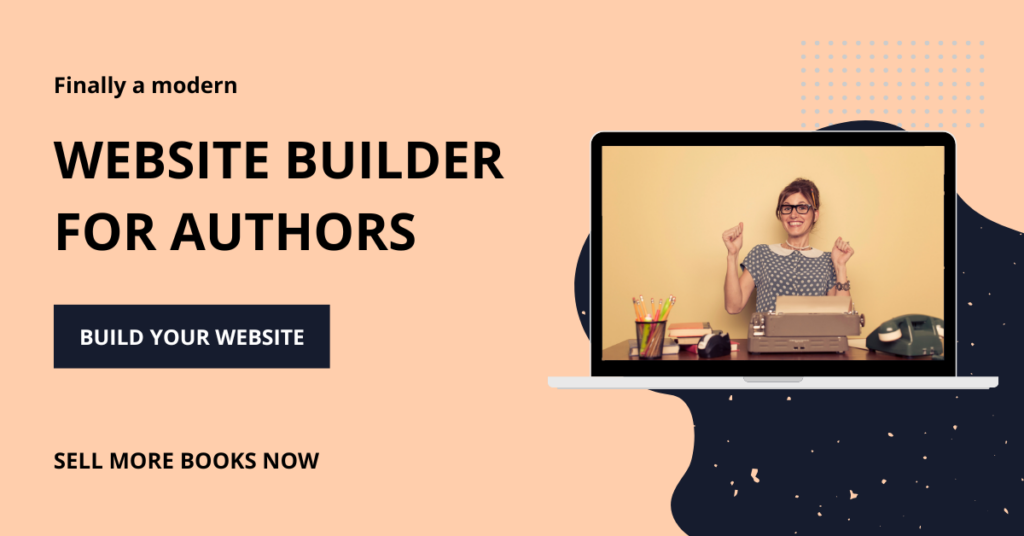In this day where technology is critical, especially in business, an author’s website is far from being just an elaborate online business card.
It is instead a key instrument for selling books and attracting a large number of readers.
Considering how most purchasing decisions are taken online, websites have the potential to become a powerful tool to persuade a reader to buy a book.
For instance, it has been reported that book shoppers who visited the author’s website within a week purchased 38% more books than the average.
With this information, we can ascertain that the more an author prominently features their work online, the more likely increase in book sales.
It goes without saying though that currently authors looking to engage with their consumers through social media need a general outline of what an effective website goes over.
One of the most enjoyable aspects of authoring is the ability to utilize creative website design concepts that will increase reader engagement.
This blog will discuss 8 design ideas that will improve an author’s website, both internally and externally, to assist in convincing a visitor to become a loyal reader.
From inviting hero sections at the top of the homepage to strategically constructed display boxes for the books we use, We portray that each element is an essential part of the optimal user experience an author is trying to provide.
Complemented with successful authors’ websites, we hope to bridge the gap for authors when it comes to envisioning their online platform, all while aiming to assist in increasing their book sales.
Why Should You Create an Author Website
For an author, websites play a vital role as they act as a single point from where all the marketing strategies are affected.
It makes it easier for the author and the reader to connect with one another and thus can help expand customers’ repeat purchase intentions.
With a website, the authors can professionally market what they are selling by presenting their works as well as writing blogs or newsletters, and keeping the audience informed about new updates.
This is also important for constructing an author’s name in the market because it aids in making book sales more frequent in the future, according to the effect this will leave on the audience.
In addition, they help in establishing the necessary authority and influence in the realm of publishing as they seem accomplished and sought for.
Today the look of the material frequently determines its worth, being refined in all spheres is quite beneficial.
It is a tremendous time saver because it helps target the readers and also the professionals by showing them that the author’s websites are not wishy-washy and that they mean business.
Because readers are authors, this situation presents opportunities for authors to be represented more frequently, which raises the visibility of their works.
Essential Design Ideas That Convert Visitors to Readers
#1. Breathtaking Authors’ Websites’ Hero Sections
A website that an author owns usually boasts the first homepage that an author’s potential readers can ever see, hence the necessity to design a hero section that gets the attention of the readers maximally.
Videos and messaging that grabs immediate marketers are included in author websites that serve to market their books.
An image with worded content serving to explain the purpose with a tagline is an important member looked for in the author’s hero section, this hero section contains the author’s own or their book cover images.
Take the home page for Notable Author Name (A good example is Chimamanda Ngozi Adichie).
The author with the highest sales, for a visually captivating example of what a hero section may look and function like, they endorse a motivating and attention-catching CTA that seeks to urge readers to click and buy their current book on show.
This method not only makes visitors stay on the webpage for even longer but also provides the visitor with the most relevant content as soon as they enter the paper.
#2. Strategic Book Display Galleries
An author’s website can easily be made more user-friendly with an engaging book display gallery as it helps users look for the books more seamlessly.
To create a visual hierarchy this feature can allow the important pieces to be displayed while allowing an integrated search option to locate the author’s work with ease.
This includes options such as book covers that have hover effects as well as space for new and best-selling books.
This is well illustrated in Helen Hoang where the front and back of the books are clearly featured with publication dates and purchase links.
Through effective arrangement of elements, authors can help the users focus on certain books while being able to see other pieces with ease.
#3. Author Bio Pages that Would Captivate Your Attention
There is a strong connectivity to the readers sought through an engaging author bio page, hence it is very important.
This page contains elements of relatable yet authoritative such that it consists of people’s stories and a more personal account too.
High-quality photographs of the author together with different sections regarding their influences and future writing plans are some of the effective layouts in terms of biography.
As an example, Niyati Tamaskar has designed a bio page to showcase a work of storytelling whilst bringing professionalism to the forefront.
Such biographical pages allow people to appreciate the author’s achievements and remain in touch with them by providing space for personal pursuits in addition to accomplishments.
#4. Integrating Emails into an Author’s Website
An audience needs to be formed over time, the integration of email newsletter sign-up forms into an author’s website serves this purpose greatly.
Making use of these forms as a hero section or pop-up can greatly improve subscriber rates.
Visitors can easily be encouraged to sign up for the mailing list by being provided with enticing offers such as free chapters and exclusive content.
With regards to this strategy, Jane Friedman site is a good example as they give subscribers behind the scenes information and notify them when to expect the next release.
This helps promote not only their email and contact lists but also the concept of the book and the audience already waiting for its marketing.
#5. Interactive Book Preview Features
It is a good idea for an author’s site to offer interactive features like multimedia, sample chapters, and other content, and this greatly facilitates user engagement.
By allowing visitors to make book previews using such options, authors enable potential readers and fans to establish a stronger bond with their books.
For example, J.K. Rowling came up with another interactive feature that allows readers to access the first chapter of every book on the site.
This in return makes it easier for people to use and appreciate the writing style and other important sections of the book while helping to encourage sales of the book after using certain content parts of it.
#6. Mobile-Optimized Reading Experience
As more and more users are accessing websites through mobile devices, making sure an author’s site is mobile-friendly becomes a must rather than a choice.
As fantastic as a website looks and feels, the presence of responsive design elements and a touch-friendly interface is a necessary practice daily.
A bright example is that of Melissa Bein who features an easy scrollable website that swiftly adapts from desktop views to mobile views and has fast-loaders and easy navigation features.
Such strong commitment also guarantees that any intolerance to tools will not prevent content use.
#7. Section for Social Proof and Feedback
Social proof such as testimonials or the accuracy of media mentions can greatly influence the reader’s decisions.
Featuring positive reviews or reader testimonials works towards creating trust and credibility with both the author and the works.
For example, a section of Malcolm Gladwell feature goes there discussing their books with review extracts from important reading alongside the feedback they received.
This kind of positioning works towards managing the quality of their writing and convinces potential readers to know more about their books.
#8. Effective Call to Action Design Leads
Lastly, the key elements in getting the visitors to perform specific actions would be clear call to action CTA designs.
This could help get a visitor to buy a book or subscribe to a newsletter or some other marketing strategy.
Conversions can improve remarkably where visually appealing buttons with appropriate text direct users to the next step and informative stage.
On the website of Jane Friedman, Calls to Action have been provided on almost all the pages of the site.
This is done so that every time a reader visits the author’s site regardless of the page it is, they will always be motivated to reach out to the author’s works again.
Implementation Tips
Authors aiming to put into place these design concepts should, when necessary, engage website designers who are very much familiar with design intricacies that are applicable for writers.
Or, there are so many options for website builders out there and they can do all the job without writers.
Considering the expenses is important as well; every investment that is made in quality design pays dividends in greater visibility and eventually even increased sales.
Depending on the goals and resources, authors should balance between hiring professionals and using convenient services.
Read also: How To Create a High-Converting Author Website Landing Page
Avoid Making These Mistakes
Making sure that you have the right author website is one thing, but an author website is expected to look the same way for many years, and as a common mistake, it is vital to make sure that it doesn’t.
If a piece of content is not relevant, then a visit has a high chance of being discouraged by it, so ensuring instant access to updates related to design or content should go hand in hand with making this excuse.
Furthermore, subpar navigation systems might be exasperating for users so instead of being directed freely around the use of the site, users are sent to unnecessary parts without any clear goal.
If an author wants to enhance the search engine optimization then the overwhelming content display is a menu for disaster because it is vital for an author to save punctuation and to chop up walls of text into paragraphs.
Read also: Boost Your Author Website Traffic: 8 Proven Strategies

Conclusion
An author’s ability to merchandise their book extensively and best communicate with readers can greatly improve by following these sets of design principles to successfully enlarge an author’s website which regularly requires an overhaul since it is an active place and viewed as a vigorous place rather than a regurgitated page. A sincere effort and a good amount of time should be sunk in to better the design today because this will lead to an easier audience grab tomorrow.
Read also: Author Website Marketing: 11 Strategies for Success

